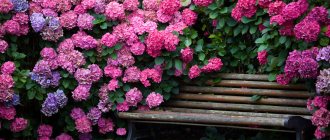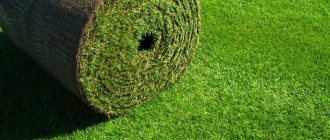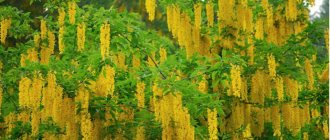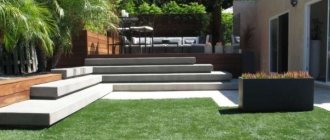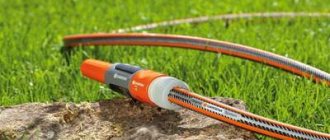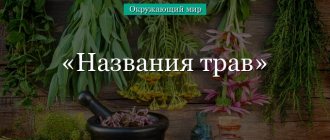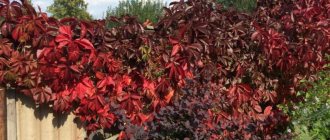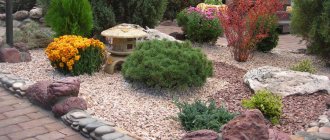What is a rolled lawn, its composition, advantages and disadvantages
Growing lawn grass naturally is a long process. It consists of several stages:
- selection of seed variety;
- soil preparation, including leveling and compacting it, loosening the top layer;
- sowing;
- regular watering.
In the absence of experience, the result may not always please you. Uneven growth of grass is possible, forming peculiar bald spots. These areas have to be re-seeded and wait for new shoots to emerge.
All these difficulties can be avoided by laying rolled lawn on the landscaping area. It is a layer of turf with already grown grass. Moreover, it is guaranteed to be free of weeds.
Many gardeners believe that this is a dense layer of turf, rolled up like a roll of wallpaper. This is partly true, but in fact the structure of this decorative coating is more complex and depends on the growing method. Often, mesh, geotextiles or thin felt are used to form a denser root layer.
The fertile layer under the rolled lawn should have a thickness of 8 - 10 cm
The advantages of rolled lawn are obvious:
- rapid landscaping of the territory (within several hours or days, depending on the area of the area being landscaped);
- trouble-free cultivation on the most difficult, clay and rocky soils;
- Possibility of installation on slopes and terrain with complex terrain;
- Does not require as much care as a natural lawn;
- high degree of decorativeness;
- ready for use 2–3 days after installation.
There is only one drawback: the high price.
Natural foundations of turf
In nature, such formations are called turf. Most often they form in the steppe or in wastelands used for pasture. Animals constantly trample and bite the grass, so it cannot develop tall ground shoots, but it constantly grows rhizomes that are so tightly intertwined with each other that no other plants can grow here. They simply do not reach the level of the soil hidden under dense shoots.
Moreover, the seeds of the very grass that formed the turf cannot germinate. As a result, seed regeneration is replaced by vegetative one. The plant is increasingly “invested” in the rhizomes, which form such a dense grass carpet that it can actually be rolled up and moved to another place.
When buying a rolled lawn, pay attention to the quality of the turf
Not all plants can form dense turf. Most often, cereals choose this strategy for spreading and capturing territory. For example, grasses such as clover and knotweed can form a monospecies carpet. Such a lawn is not only resistant to mechanical stress, but also constantly blooms beautifully.
Growing methods
Growing a rolled lawn is a slow process and requires special knowledge. It takes at least two years for a dense layer of turf suitable for cutting to form. To date, two methods have been developed that are used by manufacturers of landscaping materials.
Using a mesh
The use of polymer mesh "Tanax Radix" and Tama-Net allows you to reduce the time for growing lawn grass. This is a lightweight and very durable synthetic material with a small mesh. It is produced in rolls with a width of 75, 100 and 120 cm. Large-scale production uses sheets with a width of 5.4 m.
The cellular structure of the mesh allows you to maintain the integrity of the soil layer during the formation of the turf. Once the technical maturity of the lawn has been reached, the substrate will allow it to be easily rolled up.
Grass in rolls is grown in open areas and in greenhouses
The cultivation technology consists of several stages.
- Soil preparation. In a field intended for sowing grass, plowing, milling and leveling of the soil are carried out. At the same time, herbicides necessary to kill weeds are applied. At the final stage of soil preparation, it is rolled to obtain a smooth, medium-density surface.
- Mark the area for laying the polymer mesh.
- Lay out the synthetic material.
- A thin layer of loose, fertile soil (2–3 cm) is poured on top of it.
- Surface sowing of grasses is carried out using seeders.
- Roll the soil. Using a stationary irrigation system, the soil is kept moist. Mineral fertilizers are added along with water.
- The finished lawn is cut by rolling it into rolls. If there is a mesh, this is done manually, without much labor.
The main advantage of this method is that the herbs can be grown in the same place many times. There is no need to leave the field fallow, allowing the land to rest.
Without using a mesh
The growing technology is no different from the previous one, except that it does not use a polymer mesh. This method has its disadvantages:
- the need to use special equipment for cutting turf and laying it in rolls;
- the thickness of the dense layer can vary and depends on the quality of the soil (lawns grown on peat soils are up to 15 mm thick);
- Thin sheets may fall apart into fragments.
This method of cultivation requires more careful care, including regular fertilizing necessary for the formation of turf.
Selection of herbs
All the grasses that make up the lawn have their own purpose. This is due to the characteristics of the plants. Some of them resist the appearance of weeds, others are distinguished by high seed germination, others tolerate drought well, and others are resistant to trampling.
In order for the grass to take root, it needs to be provided with high-quality watering.
For this reason, when growing a rolled lawn, grass mixtures are always used. Most popular:
- 60% bluegrass, 30% fescue, 10% ryegrass (all-purpose);
- 80% fescue, 20% bluegrass (tolerates shade well);
- 50% meadow bluegrass, 25% red fescue, 25% ryegrass (resistant to trampling, recovers quickly, grows evenly).
Choosing a quality lawn
Rolled lawn is nicknamed for its specific method of transportation; it is also called ready-made lawn.
Coating production methods are divided into two types:
Sowing seeds on an agrofibre mesh. First, the soil is treated with special preparations, leveled, compacted and a mesh is laid out. Place the seeds on top and cover with a 2 cm layer of soil. Water so as to prevent the soil from drying out. After weaving the roots of the sprouted grass with the mesh, a fairly strong canvas is obtained that can be rolled up.
Growing seeds without a net. This kind of lawn is grown on black soil and peat. Grown on black soil, it is more durable and better adapts to changing conditions. It takes 1.5-2 years to get the finished product. During this time, the grass roots become so closely intertwined that they form a dense layer. This layer is cut off and rolled into rolls using special equipment.
There are two main types of rolled turf:
- The first is grass, no more than 1.5 years old. The soil layer on it does not exceed 15 mm. The size of the panel is 2000 * 400 mm.
- The second one is made on a plastic mesh and is 2.5 months old. The dimensions of this artificial lawn are 3000 * 750 mm.
The soil on which the rolled lawn was grown should be close in composition to the earthen environment on your site. Otherwise, the plants may not take root.
The best rolled lawn is uniform and does not have yellowed grass on it. The greens are thick, juicy green in color, the root system should not be overdried - it should contain young white roots.
Be sure to check the quality certificate, do not take the seller’s word for it. Among the declared rolled lawns from the manufacturer, there are often fakes. While inspecting the roll, shake it by grasping the edge. A good quality product will not fall apart before your eyes.
Pay attention to whether there are a lot of weeds on the lawn, whether the plants look healthy, and whether the roots are tightly intertwined with the turf. Also remember - a lawn grown according to all the rules cannot cost a penny, most likely there is something wrong with it.
Kinds
Depending on the grass mixture used, the method of cultivation and laying technology, several types of lawns are classified. Each of them has its own characteristics of care and operation.
According to their purpose, there are three types of landscape coverings:
- decorative;
- special (characterized by the high endurance of herbs, intended for the design of urban areas, airfields, roadside areas);
- sports.
Parterre
Parterre is the most highly decorative and presentable of all existing types of lawns. Otherwise it is called English. Its function is to decorate the territory. The ground lawn is distinguished by its rich green color, pleasing to the eye from early spring to late autumn. Widely used to design park areas, areas around cultural and artistic monuments, and areas around government institutions.
Excessive demands are placed on the ground lawn
Peculiarities:
- predominance of narrow-leaved grasses: fescue and bentgrass;
- requires careful care and regular haircuts;
- not intended for human walking and animal walking;
- Before laying rolled grass, careful soil preparation is necessary.
To create a dense, uniform lawn, use the following grasses:
- bentgrass, shoot-forming, white and common;
- perennial tares;
- fescue;
- mint;
- ryegrass
There are ready-made grass mixtures, by the name of which different types of parterre lawn are distinguished:
- "Barenbrug";
- "Trifolium";
- "Emerald";
- "Greenmeadow";
- Green line.
Universal
The most common type of lawn is universal. It belongs to the decorative category, but unlike parterre, it is unpretentious and does not require such careful care.
The universal lawn is popular in both urban and private buildings
The herbal mixtures include:
- red fescue;
- sheep fescue;
- meadow bluegrass;
- English and perennial ryegrass.
Planting density - 1 kg per 30 m2. On the universal lawn you can sunbathe, arrange recreation areas, and play outdoor games.
Shadow
To design shady areas you will need a special, shade-tolerant lawn. It is the most difficult to grow and care for. It should be understood that any lawn grass does not grow well in the shade.
A shady lawn also grows well in sunlit areas.
There are grasses that tolerate partial shade. The most popular grass mixture for a shady lawn consists of these:
- perennial ryegrass - 15%;
- meadow bluegrass - 15%;
- 15% each of sheep and red fescue;
- rough fescue - 10%;
- thin bentgrass - 5%.
On a note! Many gardeners are perplexed why even a shady lawn does not grow well under trees. The point is that the herbs require light: over time, they weaken in the shade and wither. Therefore, this type of landscape covering requires regular reseeding every 2–3 years.
Urban
To grow roll-up lawns intended for use in the city, grasses that are highly resilient are used. They are able to grow well in conditions of gas pollution and traffic.
A quality turf can provide a safe surface for children
The two most popular grass mixtures are:
- “Urban”, consisting of 15% timothy, 50% meadow fescue, 15% perennial ryegrass;
- “Road”, consisting of the same herbs, but in a different percentage: 30, 40, 30%, respectively.
Moorish (flowering)
The most picturesque lawn, the distinctive feature of which is the presence of wildflowers. This decorative coating is a good choice for decorating summer cottages and garden plots, residential areas in residential urban areas. It is easy to grow and care for and does not require regular trimming.
The only lawn that needs mowing once a year is the Moorish lawn.
It is created by adding flower seeds to grass mixtures for urban lawns:
- forget-me-nots;
- mignonette;
- red clover;
- poppy;
- daisies;
- flax;
- bells
Attention! When choosing a Moorish lawn for your site, take into account that it will invariably attract bees and butterflies. Therefore, its use near an apiary is irrational: rest in this area will be complicated by the presence of insects.
Herbal mixtures used for lawns
Seeds for planting are usually taken from such types of cereal grasses as: perennial ryegas, some types of fescue, bentgrass, and bluegrass. The combination of fescue and bluegrass in a mixture is considered balanced. They complement each other perfectly.
In hot weather, the fescue towers above the bluegrass, which has folded its leaves, and if it gets colder, the bluegrass blooms them in all its glory. Fescue has established itself as an unpretentious, hardy grass that is little susceptible to disease, it tolerates hot weather well and can grow in the shade.
Meadow bluegrass is more demanding of care. With insufficient attention to itself (untimely watering or mowing), it loses its color saturation. This plant loves sunny areas, but begins to wither in the shade. But bluegrass is quite frost-resistant. With optimal care, such a lawn will delight you for several decades.
- Indoor ventilation
Choosing grass for the lawn
Deutzia is blooming - summer is coming
The lifespan of rygas, a plant that is often included in lawn mixtures, is about 3 years. It is included in the composition because it has rapid germination and bright color.
The lawn on which one rygas is planted is short-lived; at first it bushes, which looks untidy, and after two years it begins to thin out. This happens at any sowing density; the reason is the lack of rhizomes.
Bentgrass is also used in lawns, especially golf courses. This plant often gets sick and responds poorly to insufficient care. When there is an excess of it in the mixture, bentgrass fills the entire space, displacing other herbs.
Roll delivery format
The production of rolled lawns on an industrial scale adheres to certain standards. These are the basic requirements for growing and supplying landscape materials.
- Standard rolls. It is the easiest to install due to its small dimensions and weight. Average thickness 20–30 mm, width 400 mm, length 2 m. Roll weight 18–25 kg.
- Slab rolls. It is cut specifically for repair work: filling bald spots in the lawn and decorating small areas of open ground around green spaces. The thickness of the turf with grass is 20–30 mm. Roll dimensions 40x100 cm. Weight 10–12 kg.
- Smart rolls. This format is optimal for landscaping large areas. The thickness of the turf sheet is 20–70 mm, width 550 mm, length 26 m. Roll weight 250–360 kg. Laying is carried out using special equipment and the efforts of several people.
- Big rolls. Another format for landscaping large areas. Optimal for landscaping sports facilities. Roll dimensions 1.2x26 m. Thickness 3–7 cm.
Best Artificial Grass
This type of coverage is suitable for those who do not want to spend a lot of time planting, growing and maintaining a live lawn. It is undemanding to living conditions and in most cases looks quite natural. This can all be said about the three models described in this rating.
RealGrass
This grass is most often used for decorative purposes - in cafes, summer areas, restaurants and photo studios. It is also laid on children's and sports grounds where they play football. Despite its artificial origin, the lawn looks quite natural. It is characterized by a long monofilament pile 3.5-4 cm high, but it does not get tangled and is easy to clean if necessary.
The grass has a rich olive green color that makes it look like natural plants. The coating is uneven in tone. The finished lawn is supplied in rolls of 2 and 4 m wide, already prepared for installation. There is no need for special soil preparation for this and you can do without filling it with sand and rubber granules. It is enough to spread the product on a flat concrete, asphalt or sand base.
Advantages
- Does not fade when exposed to UV rays;
- Does not require watering;
- Does not require fertilizing;
- Pleasant for walking barefoot;
- An exact imitation of a real lawn.
Flaws
- Over time, the pile may become a little frayed.
According to reviews, in the absence of experience working with artificial landscaping, it is easier to lay narrower rolls 2 m wide.
Condor Phoenix 3013
Artificial grass “Condor Phoenix 3013” is short, its pile length does not exceed 3 cm. Thanks to this, it is convenient to relax and play football on it. The soft part is not heavy - 809 g/m2, the total weight of the product is 1676 g/m2, making it easier to install. It is sold in a 25 m long roll, so it is very convenient for installation in large areas. This model has an undercoat that gives it realism. A high-quality rubber base increases service life and is practically odorless. The grass is well preserved when exposed to sunlight and does not deteriorate due to frequent rains.
Advantages
- Sold in rolls 2 m and 4 m wide;
- Does not become slippery after rain;
- Does not require careful site preparation;
- The pile is well preserved over time.
Flaws
- Not the highest fire safety class;
- The pile may need to be combed out.
Artificial grass “Condor Phoenix 3013” can be purchased not only in rolls, but also cut. However, in this case the price will be almost 20% higher.
Domo Deco Green Grass 40
First of all, this artificial turf stands out in the ranking because it is oriented towards football fields. The composition is based on polypropylene, which is characterized by safety and long service life. The pile here is quite soft to the touch and is suitable for sports shoes. The smooth coating guarantees better traction with the sole, and resistance to moisture means no slipping after rain.
The pile of this model is 4 cm high, even and moderately thin. It is immune to the effects of sunlight and frost, retains the intensity of its green color during regular use and does not absorb foreign odors. It is distinguished by increased resistance to trampling and physical stress. The length of the roll is 25 m, so it can cover a considerable area.
Advantages
- Optimal rigidity;
- Attractive price/quality ratio;
- It is pleasant to walk on the surface barefoot;
- Easy to lay;
- Bright green color.
Flaws
- Doesn't look very natural.
Like most artificial turfs, Domo Deco Green Grass 40 synthetic grass is sold in rolls of 2 and 4 m wide.
What to look for when purchasing
Having decided to purchase such a lawn, you need to understand that not all promises of manufacturers are guaranteed to come true. For the first time after installation, the green area looks great. But next year only a small part of this beauty may remain.
Before purchasing, it is recommended to roll out the roll and visually evaluate the quality
The reality is that the market offers too few complete 3-year-old lawns. Manufacturers mainly sell materials from the first and second years of planting. They have a significant drawback: not fully formed turf. This is the first point you need to pay attention to when choosing.
Lawn quality indicators
Main selection criteria:
- no smell of rottenness;
- optimal density - 50 blades of grass per 10 cm2;
- there should be no bald spots or yellow grasses;
- well-formed dense turf with an abundance of white roots;
- uniform roll thickness along its entire length;
- no weeds.
Advice! From gardeners and landscape designers you can hear a recommendation to choose a rolled lawn using a cigarette pack. The following parameters must match: the thickness of the pack and the turf layer, the height of the pack and grass.
Review of popular manufacturers of rolled turf
Each region has its own producers of grass rolls. This type of landscape material is suitable for long-distance transportation, but this opportunity is rarely used. The reason is that the cost of the roll increases significantly due to the costs of paying for the services of the transport company.
In Moscow and the Moscow region, several manufacturers have the largest number of positive reviews:
- "Lawn Traditions";
- "Etalon" (formerly "Standard");
- "Lawn City";
- "Alpha Lawn";
- "Russian lawns".
Popular in Kuban (Krasnodar Territory):
- "World of Lawns";
- "Greening of Kuban";
- "Southern Lawns";
- "Russian Lawns Landscape".
In Kazakhstan and the Ural region, the most famous large manufacturer of rolled landscape coverings is Ural Lawns.
Brands such as Ecoteck, Hunter, Barenbrug, Hubner-Lee are always popular. These enterprises supply their products to every corner of the Russian Federation and the CIS.
How to determine the required number of rolls
When ordering a rolled lawn, you can tell the manager the area of the area to be landscaped, and the specialist will make all the necessary calculations himself.
If you want to complete this task yourself, follow these recommendations:
- Find the area of the roll by multiplying its length by its width.
- The area of the site is divided by the figure found at the previous stage.
- To the obtained value add 10% required for a slight overlap of the canvases when laying them.
Calculation of the estimated cost of a lawn for a specific area
All manufacturers provide the buyer with two price options:
- 1 roll;
- 1 m2.
To independently calculate the estimated cost, simply multiply the area of the plot by the cost of 1 m2. On average, the price for 1 m2 of Economy lawn is 86 rubles/m2. If it is necessary to landscape an area of 300 m2, perform the calculation: 300x86 = 25,800 rubles.
How to choose a good lawn?
First of all, you need to have a clear idea of what kind of lawn is best for you. You should not buy special offers of grass for your dacha, for example, sports or special ones. Of course, such products can be of high quality and very stable, but they are usually more expensive and require special care.
Just choose a good quality all-purpose turf. When selecting rolls, pay attention to the following signs:
- The turf part of the canvas should contain a large number of white roots and rhizomes, tightly connected to each other. If in all these plexuses you notice some dark spots, check to see if it is rot. Of course, a dry leaf or dark pebble may get stuck in the thick of the roots. However, if several roots or shoots are dark-colored, then such a roll should be rejected, since it may be infected with some disease.
- A healthy lawn roll should have a bright and uniform color.
- Typically, a well-formed lawn has the same thickness of the turf layer along its entire length.
- Carefully inspect each roll you purchase for signs of disease and the presence of any pests.
- Before you go to the nursery to purchase your lawn, read reviews about the manufacturer and their product. This will help you avoid mistakes and spend your money wisely.
When and how to properly lay lawn grass in rolls with your own hands
Experts do not recommend watering the lawn before transportation, since dry turf better withstands mechanical stress. Therefore, it is advisable to warn the manufacturer or distributor about the pickup time. If the order is delivered by a company, you need to ask when the grass was last watered.
Important points:
- the optimal time of year for laying rolled lawn is spring or autumn;
- the weather should be dry and cool;
- the best time to carry out work is morning or evening;
- rolls must be laid within 1–2 days after purchase;
- Before the work is completed, the brought materials are stored in the shade and not watered.
Installation instructions
When laying a rolled lawn yourself, several steps are performed sequentially.
Before laying a rolled lawn, you need to thoroughly prepare the soil.
Soil preparation
- Using a rake or other household equipment, clear the area of debris, stones, fallen leaves, and branches.
- Treat the area with herbicides, following the manufacturer's instructions. Optimal means for weed control: “Agrokiller”, “Antiburyan”, “Antipyrey”, “Arsenal”.
- 5–7 days before laying the rolls, mineral fertilizers are applied.
- Level the area using shovels, rakes, and a long, flat board.
- Compact the soil. At the same time, it is monitored that garden paths and paths do not rise above the areas to be planted by more than 25 mm.
Roll stacking
When performing this task, do not stand on the prepared soil or roll being unrolled. A couple of boards are laid along the work site, which are moved as they move to the other edge of the site.
- The roll is unrolled strictly in a straight line.
- Having completed the work, compact the resulting mat by rolling it with a roller. This will improve the adherence of the turf to the ground and remove air. It is important not to overdo it: do not crush or tear the fabric.
Rolled grass cannot be stored for a long time - To lay the second and subsequent rolls, perform the same steps as in the previous stage. The lawn blades should be located close to each other, but staggered: in a checkerboard pattern.
- After the lawn is ready, it is rolled with a roller across the seams.
- The edges are formed by cutting the turf in a straight line with a sharp knife, bayonet shovel or hoe.
Important! If the area has a rounded shape, when laying the canvases, you should not try to bend them in the desired direction. The required shape is achieved by trimming.
Purchase and storage of lawn
The structure of the rolled lawn is formed in such a way that immediately after purchase the “turf mat” must be used for its intended purpose. Such a product cannot be stored for a long time. This is why roll lawns are not purchased in winter or early spring.
Once the turf has been cut and transported to the site, the lawn should be laid on the first day. Maximum shelf life is 2 days. Therefore, soil preparation for landscaping on the site should be carried out shortly before purchase.
Basic rules of care
Immediately after laying the grass, water it well. Further care consists of performing a set of measures.
Rolled lawn requires comprehensive care
Summer
- In dry weather, water the lawn generously 1-2 times a week in the evening.
- Trim regularly, making sure that the height of the grass is within 4–7 cm. The optimal frequency of cutting is once a week.
- After every second grass mowing, Kemira Lawn fertilizer is applied at the rate of 5 kg per 1 sq.m.
- Remove weeds regularly.
Autumn
- In the first ten days of September, potassium (20–30 g/m2) and phosphorus (5–10 g/m2) are added.
- Water depending on the weather, on average once a week (in the absence of rain).
- The period of the first frost in a given climate zone is determined, and cutting is stopped 20–30 days before this date.
- Before snow falls, fallen leaves are removed.
Winter
- You cannot walk on the lawn.
- No special care required.
Spring
- After the snow has melted, comb the lawn with a rake, removing debris and old “felt.”
- Spring feeding consists of nitrogen at a rate of 5 g/m2.
- The first fertilizing is carried out after the grass begins to grow. Potassium (20–30 g/m2) and phosphorus (5–10 g/m2) are added.
Preparatory activities
Before laying the rolled lawn, you should take care of the surface on which the “living mat” will grow. The site is thoroughly cleaned, removing construction and household debris. If previously planted lawn grass has grown on the site or there are a lot of weeds, all plants are removed. All work must be done carefully.
There is no need to throw away the sod. Thrifty owners often store such biomass and then use it as compost. Site preparation also involves the total extermination of all types of weeds. The following plants are considered the most malicious:
- Snooze;
- Sow thistle;
- Coltsfoot;
- Nettle;
- Wheatgrass;
- Plantains.
Where there is particularly heavy weed infestation, it is necessary to use herbicides. Then they dig up the soil and get rid of large lumps of earth.
What are artificial lawns?
Artificial turf is an aesthetically pleasing canvas consisting of a dense base and many bright green synthetic fibers. They are identical in shape and size to blades of grass from a trimmed natural lawn. This lawn is produced in rolls, the sizes of which may vary depending on the manufacturer.
Modern technologies make it possible to produce synthetic materials that, at first glance, are indistinguishable from natural ones. Artificial landscape covering can be of several types:
- for garden and park areas;
- for sports grounds;
- for urban areas;
- for children's playgrounds;
- with wildflowers.
Artificial turf can be laid on the ground or concrete. The second option involves the presence of a special spring backing with a thickness of 10 mm. It prevents the synthetics from being pressed through. Thus, the coating retains its original appearance for a long time. Laying is done in separate sheets in a checkerboard pattern.
Artificial turf would be appropriate for children's playgrounds
Artificial lawns are chosen for various reasons. Some gardeners and owners of private houses are attracted to this material by its natural appearance, others by the lack of need for regular maintenance, and still others by the reasonable price for quickly decorating the area. Synthetic coatings have other advantages:
- high degree of wear resistance;
- practicality;
- durability;
- simple care consisting of cleaning with detergents.
There is only one drawback: the artificiality of the materials, which cannot convey the full depth and charm of tactile and other sensations experienced by a person from touching real herbs.
Rating of the best lawns
When trying to figure out which lawn is better, its type is of great importance - natural (grass or roll) or artificial. The conditions for growing plants are also important - the quality of light, weather, type of soil, the ability to organize good care - from watering to cutting. And then you should look at the specific characteristics of the product.
The basic parameters that influenced the selection results included:
- Purpose – functional or decorative: covering football fields, playgrounds, photo studios, areas in country houses;
- Composition – plant varieties and their proportions;
- Color – plain or with the inclusion of additional shades;
- Pile height and weight;
- Roll length and width;
- Presence of undercoat;
- Packaging volume of mixtures;
- Seeding rate;
- Rate of ripening;
- Quality of seedlings;
- Need for fertilizing and hydration;
- Resistance to sunlight and frost;
- Density and smoothness of the coating;
- Life time.
Also an important point in preparing the TOP was the ratio of price and quality of lawns.
The best submersible pumps
Useful reviews
There were never any problems with either the October or November installation. Theoretically, the lawn can be damaged if there is frosty, snowless weather for a long time after installation. But in my memory there were no such injuries. The record for successful lawn laying is December 22.
Sodmaster
https://www.forumhouse.ru/threads/75796/
It is only at first glance that it seems that a rolled lawn is easy, but in fact it also needs to be looked after. The most important thing is to ensure proper drainage so that the roots do not rot. It’s better to water with sprayers, and that’s not all. It seems to me that it is better to turn to specialists for laying turf.
sanek
https://www.benzotehnika.com.ua/forum/26–287–1
If you lay the rolled lawn correctly (leveling the area, treating weeds and applying fertilizers, rolling out the lawn without layering the edges, watering), then maintenance is minimal. This is watering, mowing the grass. He will delight you for years. If you order a lawn from a company, then, as a rule, they also provide installation services. Such specialists strictly adhere to all installation rules and for the next 5–7 years you will not have any problems.
vfhnf
https://www.benzotehnika.com.ua/forum/26–287–1
Rolled lawn is a worthy alternative to natural lawn and, in many respects, an advantageous decorative covering. This landscape material will provide the area with an even and uniform grass cover.
- Author: Ollgga
Rate this article:
- 5
- 4
- 3
- 2
- 1
(5 votes, average: 4.2 out of 5)
Share with your friends!
Estimated cost
The price of rolled turf from manufacturers does not differ much.
- For “ standard ” prices start from 104 rubles. per roll,
- “ universal ” – from 110 rub. ,
- “ sports ” – from 150 rubles. , "
- premium " - from 120 rub.
When calculating how many rolls you will need, you need to know that in 1 sq. m will be 1.25 rolls.
In general, a lawn grown independently and purchased in rolls requires special care and knowledge. What you can save on is up to you to decide. Each type of lawn is in demand, so choose based on your needs. But of course you can’t do without special equipment, either in preparation for installation or in caring for it.
Red fescue: tolerates shade well and does not require frequent mowing
Red fescue is a cereal plant, a grass with narrow stems of dark green color. The stems are quite tough and can be brittle in dry weather or after frost. This reduces the overall resistance of the red fescue lawn to trampling, and therefore it is often used in mixtures with meadow grass.
Red fescue has several benefits:
- shade-tolerant. It grows well, retains the density of the grass stand and a rich shade of greenery with partial landscaping. Often used for parks and gardens where there is a lot of shade from trees;
- resistant to pests and diseases, tolerates air pollution and the presence of salts in the soil;
- the emergence of seedlings and thickening of the grass stand occurs quickly, but in general the growth of the stems is slow, the lawn will not require frequent mowing;
- Fescue is beautiful: it grows densely and evenly, crowding out weeds, which allows you to get a uniform, beautiful lawn.
This cereal is demanding on soil characteristics: it does not tolerate waterlogging and grows worse on heavy, clayey soil. If there is a risk of flooding of the lawn, it is better to drain it before installing it.
uses several varieties of red fescue when growing a rolled lawn, including Maxima (shade-resistant, disease-resistant, aggressive chemical variety with a very thin leaf), Jasper and SR5130 (shade-tolerant varieties for insufficiently lit areas).
Source of the article: https://landimprovement.ru/articles/rulonnye-gazony/travy/
Varieties of grasses for seeded lawns
Fescue
There are 3 types of fescue: sheep's, red and meadow. The first two options are characterized by unpretentiousness to lighting, humidity levels and excellent tolerance to any mechanical impact. The latter species is a very capricious grass that requires regular watering and the presence of fertile soil.
Perennial ryegrass
A universal option for lawn decoration. A special feature is the speed and uniform growth of grass.
Meadow bluegrass
An unpretentious grass that takes root in any soil, copes well with weather changes, and does not require constant watering.
Polevitsa
Thin bentgrass will not take root in calcareous soil, while shoot-forming bentgrass requires planting in only a suitable type of soil. However, with plenty of regular watering, you can achieve a thick, beautiful lawn.
Clover white
This type of grass should be planted only in areas with sufficient sunlight, but even if the conditions of lighting, regular watering and care are met, it will be problematic to grow a uniform covering.
Remember that lawn seeds should be planted in an area free of any vegetation. It is even better to completely remove the top layer of soil to avoid damage to the seeds by weeds.
Tips for choosing a lawn

